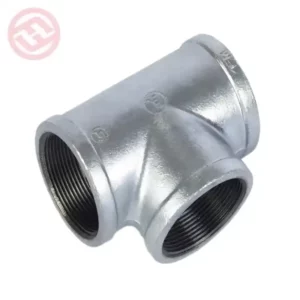Malleable iron pipe fittings are manufactured through a process called casting, which involves pouring molten iron into molds of desired shapes and sizes. Here’s an overview of the manufacturing process:
- Selection of Raw Materials: The manufacturing process begins with the selection of raw materials, typically scrap iron or pig iron, along with additives such as limestone and coke. These materials are carefully chosen to meet the desired chemical composition and mechanical properties for malleable iron.
- Melting: The raw materials are melted in a furnace at temperatures exceeding 2,100°F (1,150°C). During the melting process, the additives help remove impurities and adjust the carbon content to achieve the desired malleability and strength.
- Casting: Once the molten iron reaches the desired composition and temperature, it is poured into molds of specific shapes and sizes. Molds for malleable iron pipe fittings are typically made of sand or metal and are designed to produce fittings with precise dimensions and configurations.
- Cooling and Solidification: After pouring, the molten iron begins to cool and solidify within the molds. The cooling process may be controlled to achieve uniform solidification and minimize the formation of defects such as shrinkage or porosity.
- Shakeout: Once the castings have sufficiently cooled, they are removed from the molds in a process called shakeout. This involves breaking apart the molds to release the solidified castings, which are then separated from any residual sand or mold material.
- Cleaning and Finishing: The castings undergo cleaning and finishing processes to remove any remaining impurities, excess metal, or surface imperfections. This may involve grinding, shot blasting, or machining to achieve smooth surfaces and precise dimensions.
- Annealing: After cleaning and finishing, the castings are subjected to a heat treatment process called annealing. Malleable Iron Pipe Fittings Annealing involves heating the castings to a controlled temperature and then gradually cooling them to relieve internal stresses and improve their malleability and ductility.
- Galvanizing (Optional): In some cases, malleable iron pipe fittings may be galvanized to enhance their corrosion resistance. Galvanizing involves immersing the fittings in a bath of molten zinc, which forms a protective coating on the surface of the iron.
- Inspection: Finally, the finished malleable iron pipe fittings undergo thorough inspection to ensure they meet quality standards and specifications. This may include dimensional checks, visual inspection, and testing for mechanical properties and corrosion resistance.
- Packaging and Shipping: Once inspected and approved, the malleable iron pipe fittings are packaged according to customer requirements and shipped to their destination for installation in piping systems.
Overall, the manufacturing process for malleable iron pipe fittings involves several steps, including melting, casting, cooling, cleaning, finishing, annealing, optional galvanizing, inspection, and packaging. Each step is carefully controlled to produce high-quality fittings that meet the requirements of various industrial, commercial, and residential applications.

